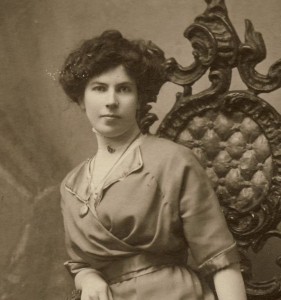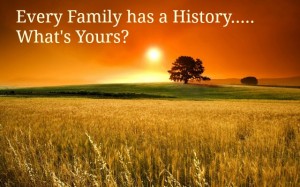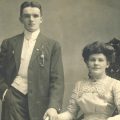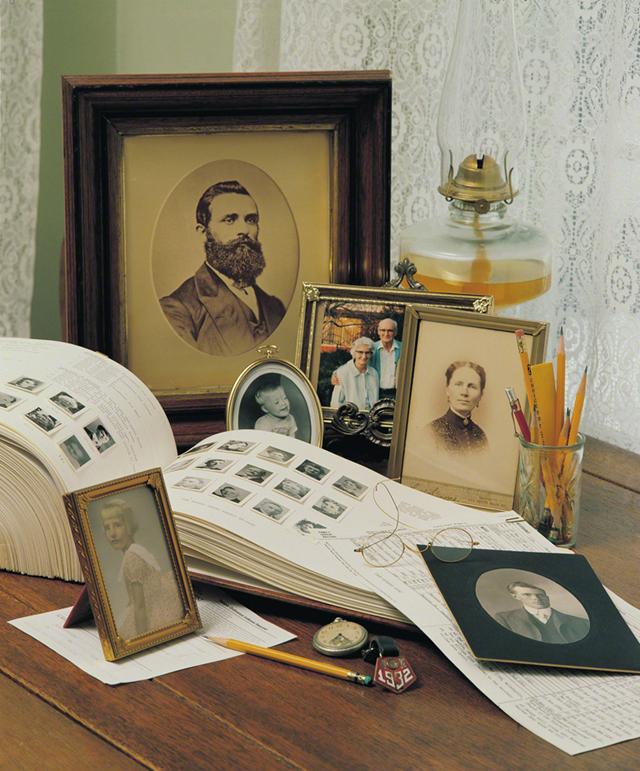What do you think of when the subject of cemeteries is mentioned? Do you think about a place of peace and calm where the dead are remembered and honored? Or do you think of cemeteries as creepy, spooky places? One of my young friends holds her breath as we drive past cemeteries so that nothing “gets” her! Whatever your reaction to cemeteries, they are very helpful for genealogists.
For most of us, our only permanent memorial will be in a cemetery. As we go back in time as written records become scarce or non-existent, a cemetery marker may be the only record of an ancestor existence, and this is especially true of children who died. While some markers contain little information, others contain a rich amount of information.
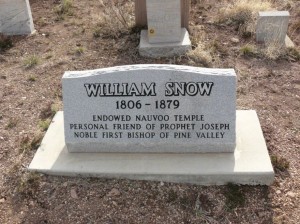 Typical grave markers today are flat slabs of stone but historically grave markers stood upright and could be quite ornate. In the Chicago area, Graceland Cemetery has grave memorials so large and impressive that tours of the cemetery are available during the nice weather months!
Typical grave markers today are flat slabs of stone but historically grave markers stood upright and could be quite ornate. In the Chicago area, Graceland Cemetery has grave memorials so large and impressive that tours of the cemetery are available during the nice weather months!
The symbols on the grave stone are sometimes as informative as the words that are inscribed on it. There are a number of websites which supply interpretations of grave stone art. Some symbols might tell you about the character of the deceased and others might indicate organizations to which she or he belonged which might lead you to additional information.
Fortunately, many of the cemeteries in the United States are cared for well either by the cemetery owners or a supporting organization. At the same time, there are a number which are not, particularly small or private ones. If you are going to venture into a cemetery that is overgrown with vegetation or otherwise uncared for, dress as you would for any other wilderness area, wearing long sleeves, long pants and insect repellent.
Years ago, my husband and me with four young children in tow, went with a cousin to visit an ill-kept cemetery where a distant relative was buried. While this may sound strange but because we had traveled a distance to reach the cemetery and our children were quite young, it seemed reasonable to have a picnic right there in the cemetery. While we weren’t dressed well for the situation, the experience was relatively pleasant. The coming days revealed our lack of preparedness as the only one of our four children who didn’t develop poison ivy was found to have an engorged tick embedded in her scalp!
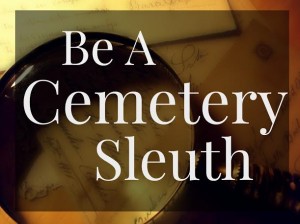 Age, weather and the environment all take a toll on grave markers and many become quite hard to read. A number of You Tube videos can be found on ways to make it easier to read difficult gravestones.
Age, weather and the environment all take a toll on grave markers and many become quite hard to read. A number of You Tube videos can be found on ways to make it easier to read difficult gravestones.
Be very careful in the methods you choose as they can be harmful to the stone and that includes shaving cream (harsh chemicals that can further harm stone) and flour (which can become food for the organisms that live on stone). Even making a rubbing of an older stone could damage the stone.
The following suggestion comes from the New Hanover County North Carolina Genweb:
Not all stones that appear hard to read are weathered to the point that they actually are unreadable. Sometimes the only thing lacking is good lighting. This point was made clear to me by something that I experienced first-hand when I visited a nearby cemetery for the first time during the winter months. In winter, not only are the days shorter, but the sun is lower in the sky than it is during the spring and summer.
The light is not as bright and full as it is during other times of the year. During my winter visit to the cemetery, I observed many very old stones that appeared to be so worn that I fully believed no one would ever again read their inscriptions. I thought that the weather of 200 years had deteriorated the carvings in the stone to the point that the carvings were little more than slight bumps and ridges on a rough stone. I could not have been more surprised when I returned to the cemetery during the early days of spring.
Suddenly it was as if the old worn stones had been replaced with newly carved, but old fashioned, tombstones. They were of course the same stones, but were given a new life under the bright spring sun. The sun shone against the stones casting shadows into the carvings, making them distinct and readable. Once again, the memorials of centuries ago were telling their tales.
In a similar fashion, the time of day and type of day you visit a cemetery can make a difference. If you visit on a cloudy and overcast day, or if you visit late in the afternoon or evening, don’t be surprised when you find older stones unreadable. If you want to be able to read old engravings well, plan your visit according to the best lighting conditions.
Visit in spring or summer, on a bright clear day, and watch the clock. Often visiting around 11 AM or noon is the best time, since the sun is high in the sky and casts important shadows from a steep angle. Just the slight difference in the angle of the sun can help or hinder reading old, faded stones.
If you are unable to wait for the spring or summer to roll around, or are unable to get to a particular cemetery during noon on a bright clear day, all is not lost. Just remember to come prepared: bring a mirror. You don’t have to pack a large sized mirror; even a small compact mirror can be useful.
The trick here is to cast the light from the sun onto the surface of the stone at such an angle that the engraving casts a shadow to make it more readable. Take a mirror and experiment. The exact method you will need to use will depend on where the sun is in the sky, which way the stone is facing, and so on. http://www.ncgenweb.us/newhanover/cem1.html
Visiting an ancestor’s grave may lead you to discover family members that you don’t know about now. This is especially true of children who died. My friend, Diane, discovered a family member recently when she visited a cemetery. Diane, while on vacation, sought out the cemetery where she knew some of her great-grandparents were buried.
She found their graves with great-grandma to the right of great-grandpa. The grave stone to the left of great-grandpa was inscribed Aunt Minnie who had the same surname as great-grandpa. Diane had no idea who Aunt Minnie was and found it a bit odd that “aunt” would be included on a grave stone. Diane’s search for Aunt Minnie’s identity and whose aunt she was, revealed a woman with a colorful life.
Turns out Aunt Minnie was great-grandfather’s second wife who he married after the death of his first wife left him a single father with a number of young children. We might suppose that Aunt Minnie was a spinster prior to marrying great-grandpa but no, the records show that he was her third husband. This was quite an interesting discovery that started with finding a grave marker for a previously unknown ancestor.
Finding a grave while at the cemetery can sometimes be a challenge. The following article from the Deseret News may prove some encouragement and strategies for locating a hard to find grave.
Recently, my sister and brother and I made a pilgrimage to a large cemetery in Southern California where several of our ancestors were buried. We approached the sexton with 12 names of ancestors we thought had been buried there. Eventually, we were given maps for seven of the 12 ancestors and we set out to find them (we were pleased they found seven of the 12).
The maps made it relatively easy to find six of the seven graves, but the seventh proved both difficult and, eventually, amazing.
Our grandmother, born Virginia David O’Cull, must have had a unique childhood. As discovered on census records and her first marriage certificate, she regularly went by her middle name, David. Both my father and I were given that same middle name. Because she, through divorce and husbands’ deaths, had five husbands, we were not sure under which name she had been buried. The sexton told us she was buried as Virginia Lanier, the surname of her last husband.
Sure enough, our grandmother’s grave proved difficult to find, partially because of her series of last names and because she was in an older section of the cemetery, where grave locations were not as precise. The sexton dispatched a cemetery worker to help us find her grave.
The map was specific but the grave was not there. After half an hour’s search the worker called for an additional, more experienced, man to help us. By this time my brother and sister had to return to our hotel.
The two workers and I continued for nearly an hour, searching the location from the map and proximate areas. Virginia Lanier was the only name the workers had. They would never have found her with that name. Finally, as the workers continued to search near the location on the map, I progressed evermore distant from that site.
Approximately 200 feet from the designated site I felt inspired to pray. As I raised my eyes I found — not six feet from me — her grave with a headstone engraved, Virginia Harrison, the name of her first husband, our father’s father.
Chills of gratitude swelled in my soul as I thought: “Thank you, Heavenly Father, for this special blessing!”
The headstone included her birth and death dates, both correct for this wonderful ancestor, whom I never had the privilege of knowing personally. But, suddenly I felt a closeness to her never before realized.
I don’t live close to any cemetery where family members are buried and haven’t been able to visit many of them. If you are in a similar circumstance, there are two great websites that can help. They are Find-a-Grave and Billion Graves. Both of these sites provide the opportunity to post pictures of grave stones online.
For Billion Graves, the pictures have to be taken with a smart phone and the Billion Graves app. So if you are able to visit a cemetery to take pictures, consider sharing them with one of these sites. If you would like a picture of a grave stone from a distance cemetery, both sites have a request service so that you can get the help of someone who lives in the area and can go to the cemetery to take a picture and post it online.
If participating in one of these websites appeals to you, you might want to consider making yourself available to be a person who can answer requests from other people by taking photos in your local area.
The summer is a great time to be out and gathering information from cemeteries. I wish you good fortune in “visiting” your ancestors at their grave site.
About Christine Bell
Christine Bell has been seeking her ancestor for almost forty years and continues to find joy in each one she finds. She volunteers in a Family Search Family History Center where she helps others find their ancestors. As a convert to The Church of Jesus Christ of Latter-Saints, she is grateful to be a member of the Church. She is a wife, mother of six grown children, grandmother of five going on six, and currently living in the western United States. Christine enjoys spending time with family and creating quilts for family, friends and Humanitarian Services of The Church of Jesus Christ of Latter-day Saints.


